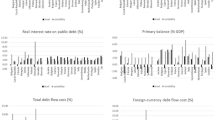Abstract
The purpose of this study is to investigate the impacts of surging debt servicing on economic growth, for the period ranging 1970–2016. Various econometric tools, such as multivariable regression and correlation etc. are used to analyse the data and conclude the results. Various errors in the data have been overcome by crosschecking of data. Smoothing techniques are also used to overcome the seasonal and non-seasonal variation in economic data. This report will generally focus on the Impacts of surging external debt servicing of Pakistan over a decade, on economic growth and will point out various areas from where our country can generate domestic as well as foreign revenues.
Access this chapter
Tax calculation will be finalised at checkout
Purchases are for personal use only
Similar content being viewed by others
References
Aghion, P., Meghir, C., Vandenbussche, J.: Productivity Growth and the Composition of Education Spending. MIT Press, Cambridge (2003)
Ang, J.: Finance and inequality: the case of India. Monash Economics Working Papers (2008)
Anwar, S., Shabir, G., Hussain, Z.: Relationship between financial sector development and sustainable economic development: time series analysis from Pakistan. Int. J. Econ. Finance 3(1), 262–270 (2011)
Anwar, T.: Unsustainable debt burden and poverty in Pakistan, state bank research bulletin, vol. 2 (2002)
Aslam, Q.: Pakistan debt position and the question of debt retirement. J. Jubilee Res. (2001)
Aurangzeb, H.A.U.: Impact of investment activities on economic growth of Pakistan. Bus. Manag. Rev. 2(1), 92–100 (2012)
Ayyoub, M., Chaudhry, I.S., Yaqub, S.: Debt curden of Pakistan: impact and remedies for future. Cprenet. Com. 2(7) (2012)
Baig, B.A., World, T.: Pakistan: why deficit financing has not worked and (2010)
Beck, T., Demirgu-Kunt, A., Levine, R.: A new database on financial development and structure. World Bank Econ. Rev. 14 (2000)
Beck, T., Demirgu-Kunt, A., Levine, R.: A new database on financial development and structure. World Bank Econ. Rev. 14(1), 597–605 (2007)
Blanchard, O.: Public debt and low interest rates. Am. Econ. Rev. 109(4), 1197–1229 (2019)
Bocola, L., Bornstein, G., Dovis, A.: Quantitative sovereign default models and the European debt crisis. J. Int. Econ. 118(May), 20–30 (2019)
Booth, L., Aivazian, V., et al.: Capital structures in developing countries. World Econ. 56 (2001)
Borensztein, E.: The effect of external debt on investment. Finance Dev. 26(3), 17–19 (1989)
Bcker, A.: A politico-economic view of the debt-servicing capacity of emerging economies. Intereconomics: Rev. Eur. Econ. Policy 33(5), 230–237 (1998)
Cohen, D.: The sustainability of African debt. The World Bank Policy Research Working Paper Series (1999)
Cordella, T., Ricci, L.A., Ruiz-Arranz, M.: Global development finance by world bank debt overhang or debt irrelevance? (1999)
Dijkstra, G., Hermes, N.: The uncertainty of debt service payments and economic growth of highly indebted poor countries: is there a case for debt relief? (2001)
Fan, E.X.: Pakistan’s public debt: a brief overview. PRM Policy Note Series 1 (2007)
Fosu, A.K.: The external debt-servicing constraint and public expenditure composition: evidence from African economies. WIDER Working Paper Series, vol. 22, no. 3, pp. 378–393 (2007)
Gomez-Puiga, M., Sosvilla-Riverob, S.: Public debt and economic growth: further evidence for the euro area. Acta Oeconomica 68(2), 209–229 (2018)
Growth, S.: World economic outlook, October 2012: coping with high debt and sluggish growth (2012)
Haider, J., Ali, A.: Impact of debt burden on economic growth: a case of Pakistan, vol. 1 (2012)
Hanif, M.N.: The journal, national institution of public administration, Karachi, Pakistan. Public Debt Manag. 7(4) (2002)
International: Debt relief and poverty reduction: meeting the challenge (2012). http://www.oxfam.org/eng/policy_papehtm
Karagol, E.: The causality analysis of external debt service and GNP: the case of Turkey (2002)
Lamont, O.: Corporate-debt overhang and macroeconomic expectations. Am. Econ. Rev. 85(5), 1106–1117 (1995)
Menz, G.: The political economy of debt (2010)
Mohey-Ud-Din, G.: Impact of foreign aid on economic development in Pakistan (1960–2002). MPRA 1211 (2006)
Morris, S., Parks, B., Gardner, A.: Chinese and world bank lending terms: a systematic comparison across 157 countries and 15 years (2020). https://www.cgdev.org/publication/chinese-and-world-bank-lending-terms-systematic-comparison
Nguyen, T.Q., Bhattacharya, R., Clements, B.J.: External debt, public investment, and growth in low-income countries. IMF Working Papers 03(249) (2003)
Pathberiya, P., Wijeweera, A.: An overview of the external debt situation in Sri Lanka. UNEAC Asia Papers 9, 1–10 (2005)
Perlo-Freeman, S., Webber, D.J.: Basic needs, government debt and economic growth. World Econ. 32(6) (2009)
Qayyum, A., Khawaja, I., Hyder, A.: Growth diagnostics in Pakistan. Development Economics Working Papers 22218, East Asian Bureau of Economic Research 24(3) (2008)
Schclarek, A.: Debt and economic growth in developing and industrial countriesh 46(0) (2004)
Staff, I.: External debt statistics: guide for compilers and users. Intl Monetary Fund (2003)
Author information
Authors and Affiliations
Editor information
Editors and Affiliations
Rights and permissions
Copyright information
© 2021 The Author(s), under exclusive license to Springer Nature Switzerland AG
About this paper
Cite this paper
Kamran, A., Syed, N.A., Qureshi, M.F., Rizvi, S.M.A., Hayat, A. (2021). Debt-Servicing Capacity and Economic Development: A Study of Pakistan. In: Xu, J., García Márquez, F.P., Ali Hassan, M.H., Duca, G., Hajiyev, A., Altiparmak, F. (eds) Proceedings of the Fifteenth International Conference on Management Science and Engineering Management. ICMSEM 2021. Lecture Notes on Data Engineering and Communications Technologies, vol 78. Springer, Cham. https://doi.org/10.1007/978-3-030-79203-9_64
Download citation
DOI: https://doi.org/10.1007/978-3-030-79203-9_64
Published:
Publisher Name: Springer, Cham
Print ISBN: 978-3-030-79202-2
Online ISBN: 978-3-030-79203-9
eBook Packages: Intelligent Technologies and RoboticsIntelligent Technologies and Robotics (R0)




